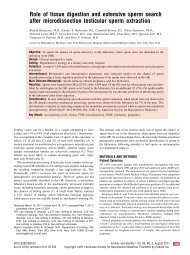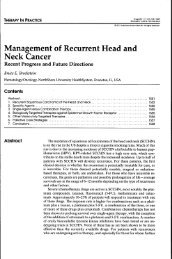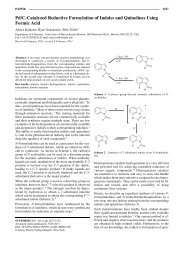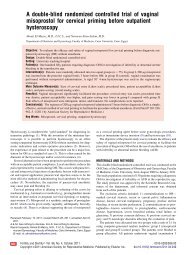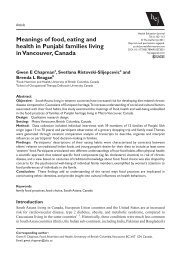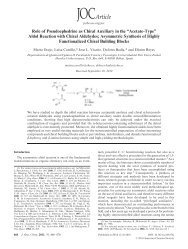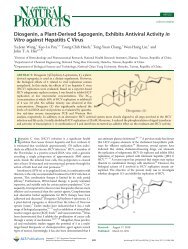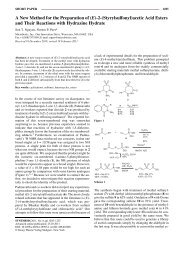Prenylated Polyhydroxy-p-terphenyls from Aspergillus taichungensis ...
Prenylated Polyhydroxy-p-terphenyls from Aspergillus taichungensis ...
Prenylated Polyhydroxy-p-terphenyls from Aspergillus taichungensis ...
Create successful ePaper yourself
Turn your PDF publications into a flip-book with our unique Google optimized e-Paper software.
Journal of Natural Products ARTICLE<br />
Table 2. 13 C NMR Data for Compounds 1 7 (recorded in DMSO-d6) a<br />
1 2 3 4 5 6 7<br />
position δC, mult δC, mult δC, mult δC, mult δC, mult δC, mult δC, mult<br />
1 125.5, qC 125.1, qC 124.8, qC 125.3, qC 114.2, qC 114.8, qC 115.2, qC<br />
2 119.0, CH 114.8, CH 115.6, CH 118.9, CH 107.6, CH 104.6, CH 107.5, CH<br />
3 144.4, qC 132.4, CH 142.1, qC 144.5, qC 143.1, qC 146.7, qC 144.1, qC<br />
4 144.8, qC 156.4, qC 144.5, qC 144.8, qC 149.8, qC 150.5, qC 148.5, qC<br />
5 115.3, CH 132.4, CH 127.4, qC 115.4, CH 99.0, CH 96.9, CH 96.7, CH<br />
6 122.4, CH 114.8, CH 131.0, CH 122.4, CH 146.4, qC 149.2, qC 149.7, qC<br />
3-OMe 56.7, CH3<br />
4-OMe 56.5, CH3 56.6, CH3<br />
10 117.7, qC 117.4, qC 118.0, qC 118.6, qC 114.5, qC 114.2, qC 114.2, qC<br />
20 148.7, qC 148.6, qC 148.6, qC 148.7, qC 149.0, qC 149.7, qC 149.2, qC<br />
30 139.8, qC 139.8, qC 139.8, qC 140.0, qC 136.5, qC 136.5, qC 136.5, qC<br />
40 132.9, qC 133.1, qC 132.7, qC 132.9, qC 131.3, qC 131.9, qC 131.9, qC<br />
50 103.5, CH 103.5, CH 103.5, CH 103.8, CH 106.1, CH 106.3, CH 106.1, CH<br />
60 153.6, qC 153.6, qC 153.6, qC 153.8, qC 149.9, qC 150.0, qC 150.1, qC<br />
30-OMe 60.5, CH3 60.5, CH3 60.5, CH3 60.9, CH3 61.1, CH3 61.1, CH3 61.1, CH3<br />
6 0 -OMe 56.1, CH3 56.2, CH3 56.1, CH3 56.2, CH3 56.4, CH3 56.6, CH3 56.4, CH3<br />
1 00 129.3, qC 129.3, qC 129.3, qC 138.8, qC 129.2, qC 129.0, qC 129.1, qC<br />
200 130.2, CH 130.2, CH 130.2, CH 129.2, CH 130.9, CH 130.9, CH 130.9, CH<br />
300 127.7, qC 127.7, qC 115.7, CH 128.9, CH 127.6, qC 127.7, qC 127.6, qC<br />
400 154.9, qC 154.9, qC 157.2, qC 127.7, CH 154.9, qC 154.9, qC 154.9, qC<br />
500 115.3, CH 115.3, qC 115.7, CH 128.9, CH 115.3, CH 115.3, CH 115.1, CH<br />
600 127.4, CH 127.4, CH 130.2, CH 129.2, CH 128.1, CH 128.1, CH 128.1, CH<br />
1 000 28.6, CH2 28.6, CH2 26.1, CH2 28.7, CH2 28.7, CH2 28.7, CH2<br />
2 000 123.4, CH 123.4, CH 123.8, CH 123.5, CH 123.5, CH 123.5, CH<br />
3 000 131.9, qC 131.9, qC 131.3, qC 131.9, qC 131.9, qC 131.7, qC<br />
4000 26.1, CH3 26.1, CH3 28.7, CH3 26.1, CH3 26.1, CH3 26.1, CH3 5000 18.2, CH3 18.2, CH3 18.2, CH3 18.2, CH3 18.2, CH3 18.2, CH3 a 13<br />
Spectra were recorded at 150 MHz for C NMR using TMS as internal standard.<br />
C-6 (δC þ24.0 ppm). Considering the molecular formula above<br />
and the additional degree of unsaturation in relation to 1, the<br />
structure of compound 5 was found to be a cyclization product of<br />
1 between C-6 and C-2 0 via an oxygen atom. This ether bridge<br />
was further confirmed by 1 H 1 H COSY and HMBC data<br />
(Figure 1) and also supported by the chemical shift comparison<br />
with candidusin A (14) 11 and candidusin C (15). 3b<br />
The molecular formulas for compounds 6 and 7 were determined<br />
by HRESIMS as C27H28O6 and C26H26O6, respectively.<br />
Their UV and IR spectra were almost identical to those obtained<br />
for prenylcandidusin A (5), which suggested that these two<br />
metabolites were analogues of 5. Comparison of the NMR data<br />
of 6 and 7 with those obtained for 5 indicated that both hydroxyl<br />
groups at δH 9.45 (brs) and δH 9.11 (brs) were replaced by<br />
methoxy resonances at δ H 3.99 (s)/δ C 56.5 (CH 3) and δ H 3.80<br />
(s)/δC 56.7 (CH3)in6, whereas for compound 7 only one of the<br />
hydroxy signals (δH 9.45) was found to be methylated [methoxy<br />
group at δ H 3.98 (s)/δ C 56.0 (CH 3)]. The positions of the<br />
methoxy moieties were assigned at C-3 and C-4 for 6 and at C-4<br />
for 7 via HMBC correlations (Figure 1). Further confirmation of<br />
the methoxy location in 7 was provided by a NOESY correlation<br />
between 4-OMe and H-5. Thus, the structures of 6 and 7 were<br />
elucidated as prenylcandidusins B and C.<br />
The cytotoxicy of compounds 1 8 and 11 15 was evaluated<br />
on HL-60, A-549, and P-388 cell lines using the SRB 12,13 and<br />
MTT 12,14 methods with adriamycin (ADM) as positive control.<br />
Compounds 1 and 8 exhibited moderate activities against these<br />
three cell lines with IC50 values of 1.53, 8.32, 10.90 and 2.75, 3.62,<br />
1.99 μM, respectively. Metabolites 4 and 6 displayed moderate<br />
activities only against the P-388 cell line, with IC 50 values of 2.70<br />
and 1.57 μM, respectively. All other compounds showed weak<br />
cytotoxic activity against these cell lines (Table 3). Biological<br />
evaluation of compounds 9 and 10 was hindered by the small<br />
quantities of material available.<br />
In summary, we have isolated and determined the structures of<br />
seven new polyhydroxy-p-terphenyl metabolites (1 7) together<br />
with eight known analogues (8 15). <strong>Polyhydroxy</strong>-p-terphenyltype<br />
chemical entities, mainly found in mycomycetes, include<br />
scaffolds with a C-18 tricyclic or polycyclic C-18 skeleton and<br />
those exhibiting alkylated (methylate or prenylate) side chains. 4<br />
To date, less than 20 polyhydroxy-p-terphenyl metabolites have<br />
been isolated <strong>from</strong> lower fungi, with the majority reported <strong>from</strong><br />
<strong>Aspergillus</strong> section Candidi. 4,6 Members of this family of natural<br />
products, with terprenin (9) the first example isolated <strong>from</strong> A.<br />
candidus, have displayed various degrees of cytotoxicity. 4,7 Prenylation<br />
is known to play an important role in the diversification<br />
of natural products, such as propanoids, flavonoids, coumarins,<br />
and alkaloids, and prenylated examples within these compound<br />
families have been shown to exert valuable in vitro and in vivo<br />
biological activities (anticancer, anti-inflammatory, antibacterial,<br />
1108 dx.doi.org/10.1021/np2000478 |J. Nat. Prod. 2011, 74, 1106–1110



